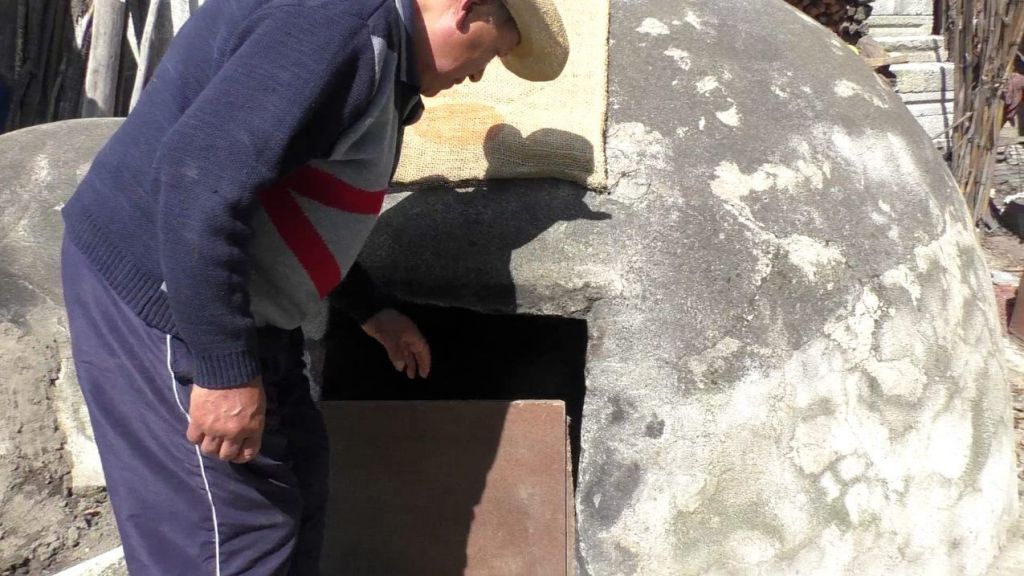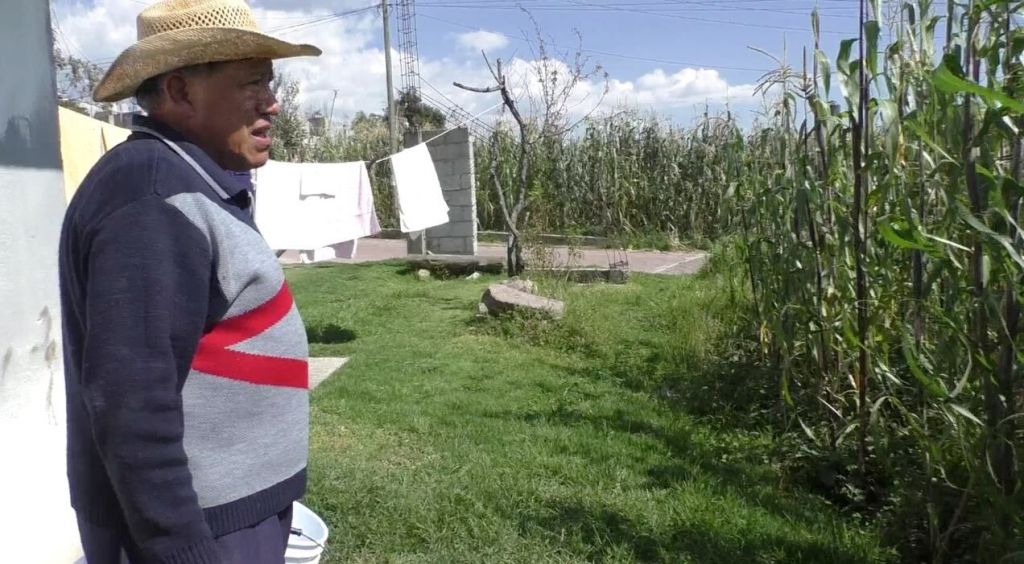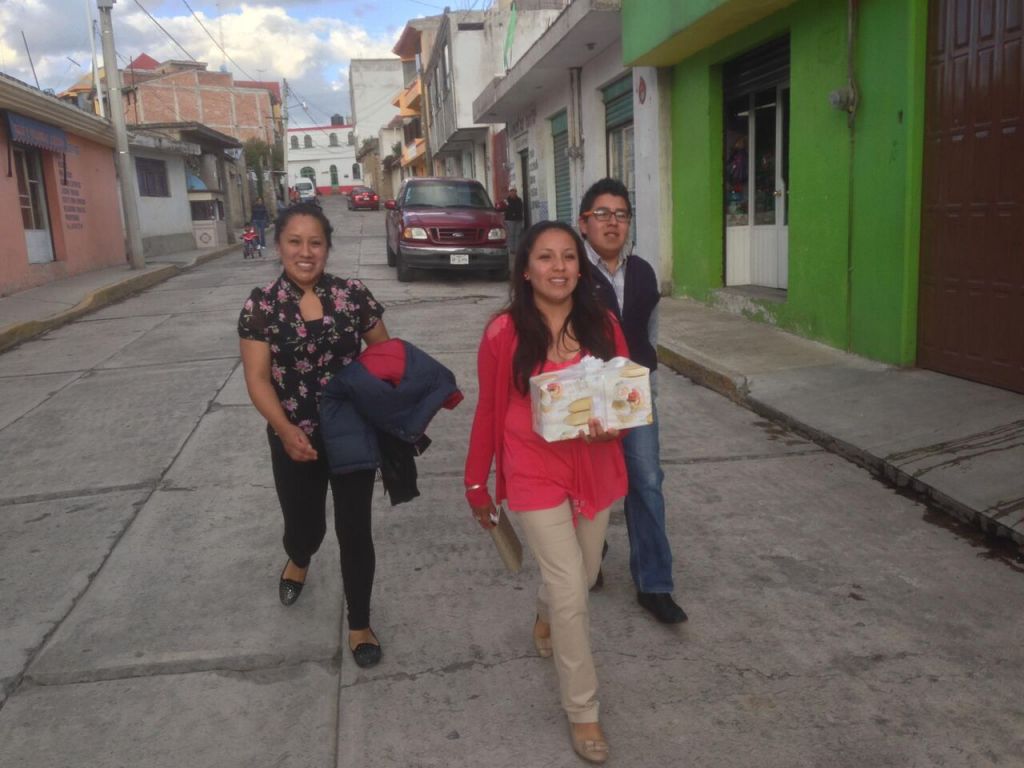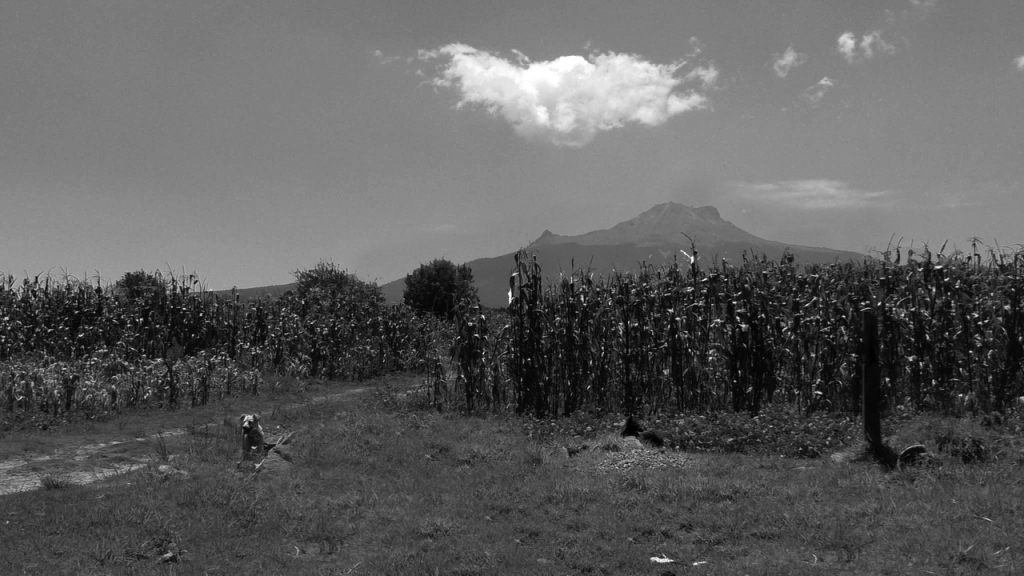“Get in, guero [white boy], it’s cold out here,” said Daniel Mendieta, naked in the mountain air. He leaned out of the temazcal built at the edge of the cornfield. The sweat lodge, bathed in crisp moonlight, had been in the family’s backyard for generations—it was the site of their monthly purification steam baths. I undressed, placed my clothes on a dusty wooden chair, and crawled into the candlelit opening.
Inside, Daniel threw a shallow bowl of water into the black hole of an antechamber in the corner of the lodge. The charred wooden logs within released a sooty vapor. It pulled on my skin with a familiar wet heat. My community, the Piscataway Indian Nation in Maryland, has a similar purification practice. This guero was an infiltrado—an undercover Indian.
“In the old days, only the gods were allowed to bathe in the temazcal,” Daniel said, kneeling next to me. “Now we are allowed.” Since European contact, the gods of this remote town in the highlands of Tlaxcala, Mexico, are composites: traditional figures like the mother goddess Tonantizin have been syncretized with Catholic saints, such as La Virgen de Guadalupe. Principal in the town of San Francisco Tetlanohcan is, of course, the beloved patron San Francisco de Asis, who dwells in the parochial church in the central square, a ten-minute walk from the Mendieta house.
A temazcal crouched behind most of the houses I visited in the farming town in Mexico’s smallest state, Tlaxcala. Though it was one of the first footholds of Catholicism in the country, the state preserved many of its older rituals. People like Daniel, a 21-year-old courier for the state government building, have kept the traditions alive. Nowadays, however, most of the ten thousand residents of Tetlanohcan don’t use their sweat lodges, Daniel explained between heaves of steamy breath. “People get embarrassed to use the temazcal. They think it’s too hick.”
Outside, corn stalks creaked in the cold mountain breeze and the pigs snored. Inside the one-story Mendieta house, where I stayed during my time in Tetlanohcan, the rest of the family filled the house with activity. Daniel’s father, Bernardo, and his youngest brother, Aldo, 18, browsed the Spanish offerings on Netflix; his sister Elena, 23, reheated mole and tortillas; Daniel’s young wife and baby son sat on the ground clapping hands, and his sister Jackie, 19, video-chatted their older brother Francisco—who lives in New Haven, Connecticut.

Francisco and his two siblings made the perilous trip North when he was 16 years old. He followed in the footsteps of over a thousand other Tetlanohquences who have come to New Haven since the 1980s. Roughly fifteen percent of the town’s population lives here—some with documentation, some without. Tetlanohcan’s migrants naturally choose a location where they have relatives and friends, who offer job opportunities and a social network. Now, the remittances from Francisco’s job at a restaurant in Orange, Connecticut, pay for the screen that allows him to talk to his sister. They pay for his siblings’ education and some of their food. They also subsidize his father’s traditional campesino lifestyle in a globalizing economy stacked against small-town farmers, especially those in largely indigenous communities.
New Haven’s Mexican population is a huge presence in the city. Traditional music plays on the streets in Fair Haven and the Hill, Mexican-run businesses dominate the neighborhoods, and the immigrant communities influence the city’s political landscape. Tetlanohcan is the town that shows most acutely what has happened to the places they have left behind. While people have streamed in from other cities in Tlaxcala and the neighboring metropolis of Puebla, from no other town has New Haven lured a comparably significant fraction.
He followed in the footsteps of over a thousand other Tetlanohquences who have come to New Haven since the 1980s. Roughly fifteen percent of the town’s population lives here—some with documentation, some without.
The money that migrants wire home is a complex force—it separates families and ushers in a corrosive American consumerism, all the while propping up Tetlanohcan’s traditional practices and allowing the town to survive economic shifts. For the young Mendietas, this contradiction is just normal life in Tetlanohcan, as they and others who have tilled the land for millennia work to hold their lost brothers and sisters close.

Over the course of the week, Elena Mendieta spreads her clothes in the grass to dry under the sun, draws water from the well to wash the dishes, and makes tortillas by hand from corn grown on her family plot. The crop is notably absent from the bouquet of produce sold at the weekly farmers’ market that takes up the entire central plaza, simply because everyone has a lot of it already. Corn used to be the main currency in Tetlanohcan, exchanged by the kilo for other goods. Since the market value of the crop has dropped, only the most dedicated farmers get up at dawn every week to barter with corn. Many just store the corn for themselves or sell it to the government for a few cents per kilo.
The Mendieta siblings grew up in a post-NAFTA world, one formed by the 1994 trade agreement that many say accelerated the destruction of the campesino lifestyle in Mexico and forced a consumer culture on people who had previously been self-reliant. Studies published in the wake of NAFTA showed a sharp drop in domestic corn sales in Mexico as larger buyers switched over to newly subsidized imported U.S. corn, starving rural and indigenous communities across the country. But in Tetlanohcan, Jackie says, there is only Mexican corn—blue, white, yellow, and sweet. “Why would we import our corn?” she laughs, bewildered, shaking a tall corn out of the sea of swaying stalks.
“When I was a little girl, I used to run through the corn stalks and feel the leaves tickle my face,” she said. “They grab your clothes a bit, and it feels funny.”
Corn is no longer profitable, so many Tetlanoquences start family side businesses to support their farms—flooring is the region’s most popular trade. And families rely on remittances sent home by relatives in the U.S. The money puts TVs and cable in the humble concrete-floored living rooms; it sends siblings to school and university; it makes sure families have better clothes and three meals a day.
“We used to only eat two meals a day, just something very small, beans and tortillas. Not a lot but that’s how it was,” said Francisca Rosette, gesturing toward her courtyard in a disjointed low-ceilinged house. “We never used to have houses like this. Now [some people] are even building two-story houses here.”
The workers in New Haven, who may never return to their Tetlanohcan, are a spectral force in their hometown. Their vacated homes, ostentatious for the town but still smaller than the average house in the Connecticut suburbs, often remain unoccupied. These dwellings represent the promise of homecoming that can take decades to realize, and the money that goes towards expanding each home sometimes fails to arrive. By the polluted pond on a foothill of La Malintzin, the construction of a huge neoclassical concrete mansion was put on hold when the owner was laid off his construction job in New York. Young men now steal and resell bricks from the unstable shell of his palace.
Back in Jackie’s yard, she tells me about the social issues that come with the imported cash. Unemployment remains high, as does crime. Corn is no longer just the staple of agricultural life. “At night, the corn makes me nervous because robbers hide between the stalks along the road.” She pointed with her lips at a dilapidated shack in a cornfield by her house. Dogs wrestled in the front and two men in tank tops stared at something far beyond us.
“Those are thieves,” she said.
The men and others like them illustrate the great social risk associated with leaving one’s children behind, even with the objective of providing for them from afar. Lucia Rosette, another woman in Tetlanohcan, explained the problem this way: with their own children and other responsibilities to care for, relatives can’t always provide the same care as a child’s parents, so generations of youth grow up unsupervised. She sees too many tired abuelos and too many of their grandchildren joining gangs, committing violence in the town, and becoming alcoholics, potheads, or drug addicts—several women interviewed corroborated the social shift anecdotally. Over chipping murals and political ads, “La Mafia” is tagged in bright orange on many prominent walls.
They subsidize his father’s traditional campesino lifestyle in a globalizing economy stacked against small-town farmers, especially those in largely indigenous communities.
On my way into the town for the first time, a thin, tattooed man in his early twenties got on a crowded convi (rural transport) and turned on a tape player with a melancholy hip hop beat. He freestyle rapped in absent monotone about his effort to make a living without being on the streets. He ended by thanking everyone on the transport and holding out his hand for donations.
It’s the same convi Jackie now takes every day to commute to Tlaxcala University, where her classes are paid for by her brother in New Haven.
While Jackie’s path forward has allowed her to stay close to home, her brothers’ and sister’s plans took them thousands of miles away. During my visit, the Mendieta clan walked together to weddings and the weekly market, dinner parties and the bus stop. Bernardo extended a rough hand into his cousin’s pickup, and waved to an aunt sitting on her porch. Every aspect of Tetlanohcan society is arranged around extended family, but everyone seems to be missing a lot of it. The missing Mendietas and their young children have been pictures on the wall for over a decade.
“I haven’t seen my son in eleven years,” Bernardo Mendieta said with an uncharacteristic tremble in his voice. “It’s a long time, a very long time.”
His children are unable to visit because they are worried they won’t be able to get back into the U.S. Bernardo himself was caught by the border patrol while trying to cross into California in the early 1990s. They took his fingerprints and deported him. He made it into the country on his second attempt, but he worked in the states for only a few months before returning to Tetlanohcan voluntarily. Decades later, this ink on his record, which many men and women in the community have, keeps him from getting a visa to visit.
People in the town send their family members goods in the mail to remind them what home is like: traditional foods, herbal medicine, and carnival regalia all travel to New Haven for events like the San Francisco carnival, a continuation of a pre-Hispanic tradition recreated in a parking lot by the Mill River. One shipping storefront stands between a dirt road by a cornfield in Mexico, and another between my house on Elm Street and Stop and Shop. But mail is not enough.
In order to cope with the seemingly universal experience of family separation in the town, Tetlanohcan women organized into a support group called the Indigenous Migrant Family Resource Center (CAFAMI), which acknowledges their indigenous heritage as part of their larger project to reclaim the town’s traditional culture. Marco Castillo, an indigenous social anthropologist from Puebla, helped form the group in the early 2000s. Benjamin Cuapio, a gruff farmer who lived in New Haven for over a decade, donated a house for CAFAMI to use about ten years ago. It sits in the shadow of La Malintzin, a titanic dormant volcano that presides over the entire valley of Tlaxcala.
At the house, a fluctuating group of roughly fifty women meets weekly to talk about the absence of family, participate in workshops on feminism (previously an unfamiliar concept in the town, they said), and practice traditional songs in Nahuatl. But there’s a decidedly pragmatic edge to their work: they have turned their personal stories of the migrant family experience, mixed with traditional song and dance, into a performance to be staged far beyond Tetlanohcan. The goal is not only to showcase traditional culture, but also to secure tickets to the U.S. with the help of sponsoring educational institutions and grassroots organizations. Threatened by American cultural influence and the town’s gradual population loss, these indigenous practices allowed them to temporarily visit their estranged relatives in the U.S. and to see the lives those families had built for themselves.
Between 2008 and 2012, CAFAMI traveled to New York and New Haven three times to perform in theaters at Yale and in Fair Haven. Audiences watched “La Casa Rosa,” a musical in English, Spanish, and Nahuatl recounting one family’s experience through the pain and complexity of migration. But the real drama occurred hours before, off stage, as the actors reunited with their siblings, parents, and children, who many hadn’t seen in over a decade.
“When I was there with my brother Francisco, I was reminded of something very old, a part of me I hadn’t felt in a very long time,” Jackie said. “I still always, always miss that feeling.”
CAFAMI’s project, however, began to slow in recent years. Some attribute it to personal divisions between the women. Others say the group was hurt by Castillo’s departure to Mexico City to run the Migrant Families’ Popular Assembly (APOFAM), an organization that uses the Tetlanohcan model to revitalize traditional cultures and find alternative ways to visit relatives in the U.S, as access to visas remains difficult.
In Tetlanohcan, there is only Mexican corn—blue, white, yellow, and sweet. “Why would we import our corn?” she laughs, bewildered, shaking a tall corn out of the sea of swaying stalks.
But the absence of CAFAMI’s support has not stopped people like Jackie from thinking of how to make moves. She is impatient to see her brothers and sister again and is hustling to make it happen. Her half-formed plans for reorganizing the women and finding a way to get back to the U.S. include applying for a startup grant and exporting traditional candies or indigenous herbal medicines to New Haven, so they could travel on a business visa.

In the meantime, families make do with long-distance contact. Calling cards are quickly becoming an artifact as migrant communities add Facebook, FaceTime, and Skype to their toolkit, keeping their bridges over the tall border fence. In my research for this article, I coordinated with the Mendietas, my contacts at the Migrant Families Popular Assembly in Mexico City, and countless sources in both Tetlanohcan and New Haven through Facebook messenger. With dicey cell service, even the older folks are picking up on their children’s technologies to stay in touch.
When I asked him about the impact of technology on Tetlanohcan, Bernardo said, “You mean this sickness?” His rough hands hit his daughter’s cracked LG smartphone touch screen. “Well, it helps. I can see my children’s faces.”
Other families are luckier than the Mendietas. Migrants with legal residence in the U.S., like Oscar De La Rosa, who has lived in New Haven for twenty-five years, allowed me to tag along with him on his visit home. De La Rosa traveled to New Haven from San Pedro Muñoztla, Tetlanohcan’s closest neighbor, in 1990, following his brother-in-law. Another relative had died on the trip north, so they went carefully. After working a variety of manual jobs, he was able to build his flooring business to a five-man crew. But since the recession in 2008, he’s been running the show himself. Things aren’t easy but he makes enough to visit his family back in Tlaxcala a few times a year—on this trip he was looking to invest in a relative’s business in San Pedro. The power was out at the festival he took me to, so the vendors flashed LED lights to attract customers like moths. He ordered a pitcher of pulke, the region’s special fermentation of mague—a succulent resembling a giant pineapple that grows by the side of roads—with the consistency of saliva.
“This is my home,” he said. “I have to come back every once in awhile to see my family and taste the air.” And the pulke. There’s no pulke in New Haven.
A two-liter bottle of soda, usually Coca-Cola, was placed on every dining table at every meal in Tetlanohcan that I visited. Mexico’s soda consumption is ranked fourth in the world, according to a Euromonitor study, and has risen over sixty percent since 1989. Jackie is the only person I met who didn’t touch it, despite relatives’ and friends’ repeated insistence.
“No, thank you so, so much, auntie, but I don’t drink soda, remember?” she apologized. She avoids it to stay healthy, but it’s hard to refuse gifts in Tetlanohcan.
As American products are making the reverse journey back to Tetlanochan in droves, Tetlanohcan youth navigate the apparent contradiction between the traditional life of their parents and the consumer culture imported from their siblings and relatives working in the U.S. As I walked home with Jackie, her 18-year-old brother Aldo glanced up from the stone basin in front of the house where he was furiously scrubbing something. He grunted an introduction, then excitedly drew his gleaming white pair of Puma sneakers from the basin, looking at the American city kid for an appraisal.

“They look American, for real, right?” he asked.
“Definitely,” I said, becoming the sneaker expert he needed. “I can see the stitching.”
“At night, the corn makes me nervous because robbers hide between the stalks along the road.”
“Yup. That’s because they are American—authentic!” he said. “My brother sent them straight from Conneteecuh.”
Inside, the hallway is cluttered with two broken speaker sets. They sleep two to a bed on worn mattresses with uneven springs.
The next day, Jackie and Elena took me to the nearest city, Santa Ana Chiautempan, for its annual fair. We rushed through the obligatory historical exhibit leading the fairgrounds, featuring toy dioramas of Tlaxcala’s history. The mismatched “Indian” figurines were bare-chested and peeling. The exhibit ended with a towering effigy of Jesus on the cross. This display even had fresh blood dripping onto a sheet.
We walked into the gauntlet of neon lights and cotton candy. American electronic music, circa 2012, blared across the rows of shops and stalls—Bob Marley T-shirts, traditional Tlaxcalteca stoneware, fake jewelry (“no photos!”), beaded necklaces, Jesus paraphernalia. Tlaxcaltecas from throughout the valley mobbed the rickety rides, children screaming and sprinting the length of the whirling machines. Jackie and Elena picked La Himalaya, a rusted spoke that spun passengers in three-seated cars, each decorated with a freakish, spray-painted caricature of a different U.S. pop star. It’s a miracle Michael Jackson held together for as long as he did.
Tlaxcala’s eponymous capital city has a fair three times the size, they boast. Among all this gaudy foreign paraphernalia, the people of the state have permanently placed another figure at the center of the city: the statue of the great Tlaxcalteca warrior Xicohténcatl, known endearingly as “El Xico” (pronounced el SHEE-ko), for which the capital is officially named: Tlaxcala de Xicohténcatl. The ruler of the state of Tlaxcallan at the time of Spanish arrival, Xicohténcatl is most famous for intercepting and defeating Cortes’s troops and forcing them into a peace treaty. They then formed an alliance and successfully invaded Tenochtitlan, which is now called Mexico City, the capital of their Aztec rivals. But Cortes, as European invaders so often did, accused El Xico of treason and hung him.
Though Mexicans from other states tease Tlaxcaltecas, calling them “traitors” because their ancestors marched with Cortes, El Xico is an indigenous freedom fighter in Tlaxcala. He is martyred for defying both the Aztec and the Spanish to save his kingdom. Indeed, Tlaxcaltecas were spared many of the horrors that other indigenous Mexicans faced at the hands of the European invaders, maintaining a degree of sovereignty through Mexico’s early history.
I stood staring at El Xico for a long time. This chiseled indigenous masculine hero reminded me of one of Louis Hall’s militant American Indian Movement propaganda figures, which I grew up around, often depicting a Mohawk Übermensch with his back to the rising sun. But in Tlaxcala, the statue and the indigenous resistance it represents is not radical; it is totally normalized—kids climb on his benevolent toes while vendors sell their parents bubble wands. Indigeneity is an omnipresent, though changing, force in Tlaxcala.
At the Mendieta household, this back-and-forth between cultures takes place in their grandmother’s kitchen, where people speak a mix of Nahuatl and Spanish. They call it “speaking Mexican.” As we ate chiles enogadas (a fried sweet stuffed pepper) Jackie, who learned Nahuatl at home and at school, was teasing my colonized tongue at the kids’ table.
“Pa-no-tzi-no,” she sounded out. “That means good day, Sebi.”
“Here, I’ll help you, guero,” her cousin’s boyfriend poked at me. “Pah-not-SHEE-noh bro,” he said in his best Sean Connery impression. I’d been hearing it all day.
Every aspect of Tetlanohcan society is arranged around extended family, but everyone seems to be missing a lot of it. The missing Mendietas and their young children have been pictures on the wall for over a decade.
“Stop fucking with me,” I snapped back, only half joking. “No me chingues.”
Bernardo had sat me down and taught me how to curse in Spanish, worried I wouldn’t survive the family if I couldn’t defend myself.
“How do you say that in Nahuatl, abuelita?” Jackie asked.
“Chingaduria,” she obliged. Bernardo roared and smacked the table.
Jackie is set on making it back to New Haven to visit her brothers.
In the family’s cramped kitchen, she broke her situation down for me while preparing lunch: pipian, a creamy stew made from sesame seeds, nopal cactus, potatoes, and lots of chiles.
She stared down at the sesame seeds toasting in a dry pan, nutty and papery in the thin mountain air, and explained that CAFAMI, which she and many others quit in recent years, isn’t the only way to get a visa to the U.S. “It’s just a matter of getting things moving again,” she said. “We have to get the women back together and find something.”
The life enabled by her brother’s remittances will, for the time being, keep them apart.
Jackie sliced the nopal cactus paddles with a hunting knife as if they were sticks of butter. The chipotle peppers were boiling. “Well, the other thing about all this is I’m going to university soon, and that puts a sort of hold on my ambitions.” In a way, the life enabled by her brother’s remittances will, for the time being, keep them apart.
She started to fry the nopales and potatoes, throwing them around the old skillet with a wooden spoon. Then she carefully poured the hot sesame seeds, chipotles, cinnamon sticks, and cloves into a blender. “I just would like to visit the United States, spend time with my brothers and sister.” The ground spices piled on top of the nopales and potatoes, where they quickly simmered into a light pink broth, alongside a stack of tortillas handmade with corn from the family plot. She tipped back her pink Hollister cap to wipe the sweat from her brow.

At dinner, Jackie calls her brother Francisco from her smartphone. For Francisco and other migrants, the only way forward was north. There’s a restlessness to the town, one that leads people to ask what would happen if they left for good. Her brother Daniel is certainly thinking about it. But for Jackie, there’s still a future here in Tetlanohcan—one that in many ways depends on New Haven.
*Reporting from this story appeared originally in a series in the New Haven Independent.


